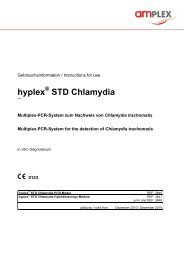hyplex SuperBug ID
hyplex SuperBug ID
hyplex SuperBug ID
Create successful ePaper yourself
Turn your PDF publications into a flip-book with our unique Google optimized e-Paper software.
Instructions for use<br />
<strong>hyplex</strong> ® <strong>SuperBug</strong> <strong>ID</strong><br />
Multiplex-PCR for the detection of carbapenemases producing bacteria<br />
in vitro diagnosticum<br />
1. Introduction<br />
The <strong>hyplex</strong> ® <strong>SuperBug</strong> <strong>ID</strong> test system is a qualitative in vitro diagnostic tool for the<br />
detection of bacteria that are capable, from a genetic stand point, of producing<br />
carbapenemases of various types.<br />
<strong>hyplex</strong> ® <strong>SuperBug</strong> <strong>ID</strong> detects all described variants of metallo-ß-lactamases of the<br />
VIM- , IMP- and NDM-type as well the OXA-48 gene and all variants of KPC.<br />
With the <strong>hyplex</strong> ® <strong>SuperBug</strong> <strong>ID</strong> PCR Module (Cat. No. 3900), amplification products<br />
are generated that can be visualised with the <strong>hyplex</strong> ® <strong>SuperBug</strong> <strong>ID</strong> Hybridisation<br />
Modules (Cat. Nos. 3901 to 3905) through reversible hybridisation with specific<br />
oligonucleotide probes.<br />
2. Carbapenemases<br />
Background:<br />
The increase in antibiotic resistance among gram-negative bacteria is a notable<br />
example of how bacteria can procure, maintain, and express new genetic information<br />
that can confer resistance to one or several antibiotics. Reports of resistance vary, but a<br />
general consensus appears to prevail that quinolone and broad-spectrum ß-lactam<br />
resistance is increasing in members of the family Enterobacteriaceae and Acinetobacter<br />
spp. and that treatment regimes for the eradication of Pseudomonas aeruginosa<br />
infections are becoming increasingly limited. While the advent of carbapenems in the<br />
1980s heralded a new treatment option for serious bacterial infections, carbapenem<br />
resistance can now be observed in Enterobacteriaceae and Acinetobacter spp. and is<br />
becoming commonplace in P. aeruginosa. The common form of resistance is either<br />
through lack of drug penetration (i.e., outer membrane protein (OMP) mutations and<br />
efflux pumps), hyperproduction of an AmpC-type ß-lactamase, and/or carbapenemhydrolyzing<br />
ß-lactamases. Two types of carbapenem-hydrolyzing enzymes have been<br />
21




